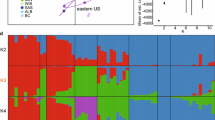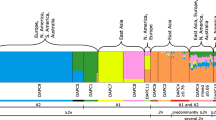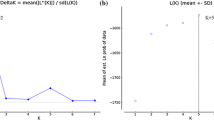Abstract
Invasive pathogens may follow stepwise spread pathways in which novel disease outbreaks become themselves sources of genotypes initiating novel infestations. Due to its worldwide distribution, Cypress Canker Disease (CCD) provides an opportunity to understand patterns of global spread of a forest pathogen. A comparative genetic analysis was performed on 110 isolates of the causal agent of CCD, the fungus Seiridium cardinale, from Europe, North America, Africa and Oceania using β-tubulin gene sequences and repeat numbers of seven nuclear SSRs. SSR data were used to calculate genetic indices for each geographic population, including those calculating allele and private allele diversity; clonal genotype, haplotype, and gene diversity; expected heterozygosity; and presence of linkage disequilibrium. Additionally, SSR data were used to calculate migration rates between regions, and to draw a minimum spanning network to visualize genetic relatedness among genotypes. Results identified the California population as a sexually reproducing, highly diverse, native population, and the Mediterranean population as a large, clonally reproducing, and exotic population directly derived from the California population. The New Zealand population appeared to be non-native, with intermediate values of genetic diversity and an asexual reproductive mode. Unexpectedly, two sources were identified for the New Zealand population: an older source was identified in California, while a more recent one was identified in the Mediterranean. Results allowed to infer migration intensity between continents, and are among the first to show that an exotic outbreak of a forest disease can become a source of pathogen genotypes for novel outbreaks in disjunct geographic regions.



Similar content being viewed by others
References
Achotegui-Castells A, Danti R, Llusià J, Della Rocca G, Barberini S, Peñuelas J (2015) Strong induction of minor terpenes in Italian Cypress, Cupressus sempervirens, in response to infection by the fungus Seiridium cardinale. J Chem Ecol 41(3):224–243. https://doi.org/10.1007/s10886-015-0554-1
Achotegui-Castells A, Della Rocca G, Llusià J, Danti R, Barberini S, Bouneb M, Simoni S, Michelozzi M, Peñuelas J (2016) Terpene arms race in the Seiridium cardinale–Cupressus sempervirens pathosystem. Sci Rep 6:18954. https://doi.org/10.1038/srep18954
Agapow PM, Burt A (2001) Indices of multilocus linkage disequilibrium. Mol Ecol Resour 1(1–2):101–102
Barnes I, Roux J, Wingfield MJ, Coetzee MPA, Wingfield BD (2001) Characterization of Seiridium spp. associated with cypress canker based on ß-tubulin and histone sequences. Plant Dis 85:317–321
Beerli P (2004) Effect of unsampled populations on the estimation of population sizes and migration rates between sampled populations. Mol Ecol 13(4):827–836
Beerli P (2005) Comparison of Bayesian and maximum-likelihood inference of population genetic parameters. Bioinformatics 22(3):341–345
Beerli P (2009) How to use MIGRATE or why are Markov chain Monte Carlo programs difficult to use. Popul Genet Anim Conserv 17:42–79
Berbegal M, Pérez-Sierra A, Armengol J, Grünwald NJ (2013) Evidence for multiple introductions and clonality in Spanish populations of Fusarium circinatum. Phytopathology 103(8):851–861
Beresford RM, Mulholland RI (1983) Susceptibility of farm shelter cypresses to three fungi associated with Cypress Canker Disease. N Z J For Sci 12(1):7–13
Bernard A, Barreneche T, Lheureux F, Dirlewanger E (2018) Analysis of genetic diversity and structure in a worldwide walnut (Juglans regia L.) germplasm using SSR markers. PLoS ONE 13(11):e0208021
Birch TTC (1933) Gummosis diseases of Cupressus macrocarpa. Te Kura Ngahere N Z J For 3:108–113
Bonthond G, Sandoval-Denis M, Groenewald JZ, Crous PW (2018) Seiridium (Sporocadaceae): an important genus of plant pathogenic fungi. Persoonia Mol Phylogeny Evol Fungi 40:96–118
Breuillin F, Dutech C, Robin C (2006) Genetic diversity of the chestnut blight fungus Cryphonectria parasitica in four French populations assessed by microsatellite markers. Mycol Res 110(3):288–296
Broquet T, Yearsley J, Hirzel AH, Goudet J, Perrin N (2009) Inferring recent migration rates from individual genotypes. Mol Ecol 18(6):1048–1060
Bruvo R, Michiels NK, D’Souza TG, Schulenburg H (2004) A simple method for the calculation of microsatellite genotype distances irrespective of ploidy level. Mol Ecol 13(7):2101–2106
Burgess TI, Wingfield MJ (2017) Pathogens on the move: a 100 year global experiment with planted eucalypts. Bioscience 67:14–25
Chou CKS (1989) Morphological and cultural variation of Seiridium spp. from cankered Cupressaceae hosts in New Zealand. Forest Pathol 19(7):435–445
Chou CKS (1990) Pathogenic variation of Seiridium spp. isolated from cankered Cuppressaceae hosts in New Zealand. Forest Pathol 20(1):32–43
Coetzee MPA, Wingfield BD, Harrington TC, Steimel J, Coutinho TA, Wingfield MJ (2001) The root rot fungus Armillaria mellea introduced into South Africa by early Dutch settlers. Mol Ecol 10:387–396
Croucher PJ, Oxford GS, Gillespie RG (2011) Population structure and dispersal in a patchy landscape: nuclear and mitochondrial markers reveal area effects in the spider Theridion californicum (Araneae: Theridiidae). Biol J Linn Soc 104(3):600–620
Croucher PJ, Mascheretti S, Garbelotto M (2013) Combining field epidemiological information and genetic data to comprehensively reconstruct the invasion history and the microevolution of the sudden oak death agent Phytophthora ramorum (Stramenopila: Oomycetes) in California. Biol Invasions 15(10):2281–2297
Cunniffe NJ, Cobb RC, Meentemeyer RK, Rizzo DM, Gilligan CA (2016) Modeling when, where, and how to manage a forest epidemic, motivated by sudden oak death in California. Proc Natl Acad Sci USA 113(20):5640–5645
Cunnington JH (2007) Seiridium cupressi is the common cause of cypress canker in south-eastern Australia. Aust Plant Dis Notes 2(1):53–55
Danti R, Della Rocca G (2017) Epidemiological history of Cypress Canker Disease in source and invasion sites. Forests 8(4):121
Danti R, Della Rocca G, Wahidi FE (2009) Seiridium cardinale newly reported on Cupressus sempervirens in Morocco. Plant Pathol 58(6):1174
Danti R, Della Rocca G, Panconesi A (2013) Cypress canker. In: Gonthier P, Nicolotti G (eds) Infectious forest diseases. CABI, Wallingford, pp 359–375
Della Rocca G, Buonamici A, Cossu C, Vendramin GG, Danti R (2009) Development and characterization of eight microsatellite markers for the fungus Seiridium cardinale. Mol Ecol Resour 9:1375–1429
Della Rocca G, Eyre CA, Danti R, Garbelotto M (2011a) Sequence and simple-sequence repeat analyses of the fungal pathogen Seiridium cardinale indicate California is the most likely source of the Cypress canker epidemic for the Mediterranean region. Phytopathology 101(12):1408–1417
Della Rocca G, Dante R, Garbelotto M (2011b) First report of Seiridium unicorne causing bark cankers on a Monterey cypress in California. Plant Dis Dis Notes 95(5):619
Della Rocca G, Osmundson T, Danti R, Doulis A, Pecchioli A, Donnarumma F, Garbelotto M (2013) AFLP analyses of California and Mediterranean populations of Seiridium cardinale provide insights on its origin, biology and spread pathways. Forest Pathol 43(3):211–221
Della Rocca G, Danti R, Popenuck T, Di Lonardo V, Garbelotto M (2018) Resistance to Cypress Canker Disease in Italian cypress has desirable effects on disease epidemiology, but may fail against novel genotypes of the pathogen Seiridium cardinale. For Ecol Manag 424:259–266
Dutech C, Barrès B, Bridier J, Robin C, Milgroom MG, Ravigné V (2012) The chestnut blight fungus world tour: successive introduction events from diverse origins in an invasive plant fungal pathogen. Mol Ecol 21(16):3931–3946
Engelbrecht CJB, Harrington TC, Steimel J, Capretti P (2004) Genetic variation in eastern North American and putatively introduced populations of Ceratocystis fimbriata f. platani. Mol Ecol 13:2995–3005
Excoffier L, Lischer HEL (2010) Arlequin suite ver 3.5: a new series of programs to perform population genetics analyses under Linux and Windows. Mol Ecol Resour 10:564–567
Excoffier L, Smouse PE (1994) Using allele frequencies and geographic subdivision to reconstruct gene trees within a species: molecular variance parsimony. Genetics 136(1):343–359
Eyre CA, Hayden KJ, Kozanitas M, Grünwald N, Garbelotto M (2014) Lineage, temperature, and host species have interacting effects on lesion development in Phytophthora ramorum. Plant Dis 98(12):1717–1727
Fuller CEK, Newhook FJ (1954) A report on cypress canker in New Zealand. N Z J Agric 88:211–220
Gansner ER, North SC (2000) An open graph visualization system and its applications to software engineering. Softw Pract Exp 30(11):1203–1233
Garbelotto M (2008) Molecular analysis to study invasions by forest pathogens: examples from Mediterranean ecosystems. Phytopathol Mediterr 47:183–203
Garbelotto M, Rizzo DM (2005) A California-based chronological review (1995–2004) of research on Phytophthora ramorum, the causal agent of sudden oak death. Phytopathol Mediterr 44(2):127–143
Garbelotto M, Guglielmo F, Mascheretti S, Croucher PJP, Gonthier P (2013) Population genetic analyses provide insights on the introduction pathway and spread patterns of the North American forest pathogen Heterobasidion irregulare in Italy. Mol Ecol 22(19):4855–4869
Garbelotto M, Della Rocca GD, Osmundson T, di Lonardo V, Danti R (2015) An increase in transmission related traits and in phenotypic plasticity is documented during a fungal invasion. Ecosphere 6(10):1–16
Geils BW, Hummer KE, Hunt RS (2010) White pines, Ribes, and blister rust: a review and synthesis. Forest Pathol 40:147–185
Ghelardini L, Luchi N, Pecori F, Pepori AL, Danti R, Della Rocca G, Capretti P, Tsopelas P, Santini A (2017) Ecology of invasive forest pathogens. Biol Invasions 19(11):3183–3200
Gilmour JW (1966) The pathology of forest trees in New Zealand: the fungal, bacterial and algal pathogens. New Zealand Forest Service, Forest Research Institute, Technical paper No. 48
Gonthier P, Warner R, Nicolotti G, Mazzaglia A, Garbelotto M (2004) Pathogen introduction as a collateral effect of military activity. Mycol Res 108:468–470
Graniti A (1998) Cypress canker: a pandemic in progress. Annu Rev Phytopathol 36(1):91–114
Grunwald N, Garbelotto M, Goss E, Heungens K, Prospero S (2012) Emergence of the sudden oak death pathogen Phytophthora ramorum. Trends Microbiol 20(3):131–138
Hamelin RC, Hunt RS, Geils BW, Jensen GD, Jacobi V, Lecours N (2000) Barrier to gene flow between eastern and western populations of Cronartium ribicola in North America. Phytopathology 90:1073–1078
Hood IA (2007) Forest pathology in New Zealand No. 8: cypress canker. https://www.scionresearch.com/__data/assets/pdf_file/0014/4181/cypress-canker-leaflet-no-8-revised-_NXPowerLite_pdf
Hood IA, Gardner JF, Hood RJ et al (2009) Australas Plant Pathol 38:472. https://doi.org/10.1071/AP09029
Hunter GC, van der Merwe NA, Burgess TI, Carnegie AJ, Wingfield BD, Crous PW, Wingfield MJ (2008) Global movement and population biology of Mycosphaerella nubilosa infecting leaves of cold-tolerant Eucalyptus globulus and E. nitens. Plant Pathol 57:235–242
Hunter S, Williams N, McDougal R, Scott P, Garbelotto M (2018) Evidence for rapid adaptive evolution of tolerance to chemical treatments in Phytophthora species and its practical implications. PLoS ONE 13(12):e0208961
Kasuga T, Kozanitas M, Bui M, Hüberli D, Rizzo DM, Garbelotto M (2012) Phenotypic diversification is associated with host-induced transposon depression in the sudden oak death pathogen Phytophthora ramorum. PLoS ONE 7(4):e34728
Kimura M, Weiss GH (1964) The stepping stone model of population structure and the decrease of genetic correlation with distance. Genetics 49(4):561
Martinelli F, Scalenghe R, Davino S, Panno S, Scuderi G, Ruisi P, Villa P, Stroppiana D, Boschetti M, Goulart LR, Davis CE (2015) Advanced methods of plant disease detection. A review. Agron Sustain Dev 35(1):1–25
Mascheretti S, Croucher PJP, KozanitasM Baker L, Garbelotto M (2009) Genetic epidemiology of the sudden oak death pathogen Phytophthora ramorum in California. Mol Ecol 18(22):4577–4590
Meirmans PG, Van Tienderen PH (2004) GENOTYPE and GENODIVE: two programs for the analysis of genetic diversity of asexual organisms. Mol Ecol Resour 4(4):792–794
Milgroom MG, Wang K, Zhou Y, Lipari SE, Kaneko S (1996) Intercontinental population structure of the chestnut blight fungus, Cryphonectria parasitica. Mycologia 88(2):179–190
Nei M (1987) Molecular evolutionary genetics. Columbia University Press, New York
Nei M, Tajima F (1981) DNA polymorphism detectable by restriction endonucleases. Genetics 97(1):145–163
Newhook FJ (1962) Cypress canker and root rot: two serious fungus disease of conifers. N Z J Agric 104:151–153
Park YJ, Lee JK, Kim NS (2009) Simple sequence repeat polymorphisms (SSRPs) for evaluation of molecular diversity and germplasm classification of minor crops. Molecules 14(11):4546–4569
Pérez G, Slippers B, Wingfield MJ, Wingfield BD, Carnegie AJ, Burgess TI (2012) Cryptic species, native populations and biological invasions by a eucalypt forest pathogen. Mol Ecol 21:4452–4471
Ponchet J, Andreoli C (1990) Compartmentalization and reaction in the host. In: Ponchet J (ed) Agrimed research programme progress EEC research cypress disease report EUR 12493 EN. Luxembourg, pp 96–111
Robin C, Andanson A, Saint-Jean G, Fabreguettes O, Dutech C (2017) What was old is new again: thermal adaptation within clonal lineages during range expansion in a fungal pathogen. Mol Ecol 26(7):1952–1963
Roques A, Battisti A (1999) Cypress pests. In: Teissier du Cros E et al (eds) Cypress, a practical handbook. Studio Leonardo, Florence, pp 74–95
Simms EL (1996) The evolutionary genetics of plant-pathogen systems. Bioscience 46(2):136–145
Spanos KA, Pirrie A, Woodward S, Xenopolous S (1999) Responses in the bark of Cupressus sempervirens clones artificially inoculated with Seiridium cardinale under field conditions. Eur J For Pathol 29(2):135–142. https://doi.org/10.1046/j.1439-0329.1999.00136.x
Sparapano L, Evidente AA (1995) Studies on structure-activity relationship of seiridins, phytotoxins produced by three species of Seiridium. Nat Toxins 3(3):166–173
Stoddart JA, Taylor JF (1988) Genotypic diversity: estimation and prediction in samples. Genetics 118(4):705–711
Szpiech ZA, Jakobsson M, Rosenberg NA (2008) ADZE: a rarefaction approach for counting alleles private to combinations of populations. Bioinformatics 24(21):2498–2504
Van der Werff HS (1988) Cypress canker in New Zealand plantations. NZ J Forest Sci 18(1):101–108
Vogler DR, Gordon TR, Aegerter BJ, Kirkpatrick SC, Lunak GA, Stover P, Violett P (2004) First report of the pitch canker fungus (Fusarium circinatum) in the Sierra Nevada of California. Plant Dis 88(7):772
Wagener WW (1928) Coryneum canker of cypress. Science 67:584
Wagener WW (1939) The canker of Cupressus induced by Coryneum cardinale n. sp. J Agric Res 58:1–46
Weston GC (1957) Exotic forest trees in New Zealand. New Zealand Forest Service Bulletin No. 13
Wikler K, Gordon TR (2000) An initial assessment of genetic relationships among populations of Fusarium circinatum in different parts of the world. Can J Bot 78(6):709–717
Wimbush SH (1944) Canker of Monterey cypress in Kenya. Emp For J 23:74
Wingfield MJ, Slippers B, Roux J, Wingfield BD (2001) Worldwide movement of exotic forest fungi, especially in the tropics and the southern hemisphere. Bioscience 51:134–140
Wingfield MJ, Hammerbacher A, Ganley RJ, Steenkamp ET, Gordon TR, Wingfield BD, Coutinho TA (2008) Pitch canker caused by Fusarium circinatum—a growing threat to pine plantations and forests worldwide. Australas Plant Pathol 37(4):319–334
Acknowledgements
The study was partially funded by Fondazione Giorgio Tesi, through an annual grant for the training of young researchers and support to genetic improvement of cypress at IPSP-CNR.
Author information
Authors and Affiliations
Corresponding author
Ethics declarations
Conflict of interest
The authors declare that they have no direct or indirect conflicts of interest in this research.
Additional information
Publisher's Note
Springer Nature remains neutral with regard to jurisdictional claims in published maps and institutional affiliations.
Electronic supplementary material
Below is the link to the electronic supplementary material.
Rights and permissions
About this article
Cite this article
Rocca, G.D., Danti, R., Williams, N. et al. Molecular analyses indicate that both native and exotic pathogen populations serve as sources of novel outbreaks of Cypress Canker Disease. Biol Invasions 21, 2919–2932 (2019). https://doi.org/10.1007/s10530-019-02022-9
Received:
Accepted:
Published:
Issue Date:
DOI: https://doi.org/10.1007/s10530-019-02022-9




